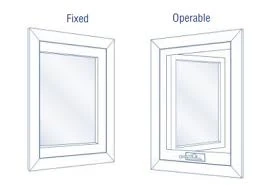When designing or renovating a home or commercial space, one of the key decisions that impacts both aesthetics and functionality is the choice between fixed windows and operable windows. Each type offers unique advantages, and the right choice depends on your specific goals—be it ventilation, energy efficiency, cost, or architectural style.
What Are Fixed Windows?
Fixed windows, as the name implies, are non-operable windows that do not open. They are typically used where light and views are important, but ventilation is not required.
Key Features:
- Permanently sealed
- Available in various shapes and sizes
- Often used for aesthetic appeal and natural light
Advantages of Fixed Windows:
- Energy Efficiency: Fixed windows are completely sealed, reducing air leakage and improving insulation.
- Cost-Effective: Generally cheaper to manufacture and install due to fewer moving parts.
- Unobstructed Views: Ideal for large, panoramic glass areas that showcase outdoor scenery.
- Low Maintenance: No mechanical components to clean or repair.
Limitations:
- No Ventilation: Cannot be opened to let in fresh air.
- Emergency Egress: Not suitable for bedrooms or areas that require an escape route.
What Are Operable Windows?
Operable windows can be opened and closed, offering both ventilation and natural light. They come in several styles, including casement, sliding, awning, double-hung, and more.
Key Features:
- Hinged or sliding mechanisms
- Provide access to outside air
- May include screens to block insects
Advantages of Operable Windows:
- Ventilation Control: Allows homeowners to regulate airflow and indoor air quality.
- Versatility: Different types offer various functions and design flexibility.
- Code Compliance: Required in bedrooms and basements for emergency escape.
Limitations:
- Higher Cost: More expensive due to moving parts and sealing requirements.
- Maintenance: Hinges, tracks, and locks need regular maintenance.
- Potential Air Leakage: Less energy-efficient if not properly sealed.
How to Choose: Fixed vs. Operable Windows
Here are some important factors to consider when choosing between fixed and operable windows:
1. Location & Purpose
- Use fixed windows in areas where views or natural light are a priority (e.g., stairwells, hallways, high walls).
- Use operable windows in spaces that need ventilation or emergency exits (e.g., bedrooms, kitchens, bathrooms).
2. Energy Efficiency
- Fixed windows are better for airtight insulation.
- Operable windows can also be efficient, especially if double or triple glazed, but may lose efficiency over time.
3. Design Goals
- Modern designs often combine fixed and operable units for aesthetic balance.
- Large fixed panes paired with smaller operable sections offer a good blend of function and beauty.
4. Budget
- Fixed windows tend to be more budget-friendly.
- Operable windows are more expensive but offer added utility.
Combining Both for Optimal Results
In most modern homes, the smartest approach is combining fixed and operable windows. For example, you might have a large fixed picture window in your living room, flanked by smaller casement windows that open for ventilation.
Conclusion
Choosing between fixed and operable windows is not a matter of one being better than the other—it’s about selecting the right type for the right location and purpose. By understanding their differences and advantages, homeowners and architects can create spaces that are not only visually appealing but also functional and efficient.
Whether you're aiming for energy savings, better airflow, or stunning views, the right window strategy can transform your space.


